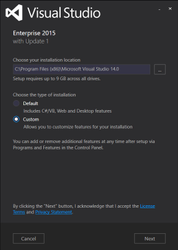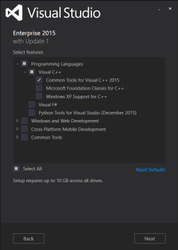| Panel | ||||||||||||
|---|---|---|---|---|---|---|---|---|---|---|---|---|
| ||||||||||||
This article is part of the Installation Guide. You can read it alone or click on the previous link to easily move between the steps.
|
...
| Info |
|---|
Processor with SSE2 support |
- Git Extensions
- Includes Git, MySYSGit, and KDiff - be sure to install all three
- View this thread for important details on how to install Git for best results. Default install options for KDiff and MySYSGit are acceptable.
- During Git installation - Adjusting your PATH environment. Pick "Run Git from the Windows Command Prompt".
- During Git installation - Adjusting your PATH environment. Pick "Run Git from the Windows Command Prompt".
Install the compiler / IDE Visual Studio Community 2017 (it's free)
The installer for VS 2017 (any edition) no longer installs the C++ compiler by default.
To enable it, select Custom in the type of installation and pick Common Tools for Visual C++ 2015 in Programming Languages -> Visual C++
You can also install it from command line with the command:
vs_community.exe /q /norestart /InstallSelectableItems NativeLanguageSupport_Groupor if you have enterprise version with:
vs_enterprise.exe /q /norestart /InstallSelectableItems NativeLanguageSupport_Group
- MySQL Server Community Edition (Use the most recent 5.6.x version or 5.5 with mysql server configuration, DON'T use 5.7 version unless you know VERY WELL what are you doing, you will have issues with 5.7)
- Download the Windows MSI Installer.
- Scroll down to the bottom and click on "No thanks, just take me to the downloads!"
- During MySQL Configuration, near the end of the installation process, create the user trinity with password trinity to match the trinity:trinity settings in the default server .conf files. Make sure that this user is set to have the DB Admin role and with Host type localhost instead of the defauilt <All Hosts (%)> because of the low security of the well known password "trinity".
- When the installation is almost done, make sure "Launch the MySQL Instance Configuration Wizard" is checked, then click "Finish".
- When the MySQL Instance Configuration Wizard launches, most default options are fine, but remember the username and password you use (root // whatever). You will need them to log into your chosen database management tool (below) in order to import SQL files later.
To test if MySQL is set up correctly, hit CTRL+ALT+DEL on your keyboard, enter the Task Manager, and select the "Services" tab. In the list of services you should see "MySQL" with a status of "Running".
Choose one of these database management tools:
mysql cli (Fastest (recomended since we use some very big files))
HeidiSQL (Best for beginners)
MySQL Workbench (already installed if you chose to install full MySQL package)
Try connecting your MySQL instance that you installed above. Depending on the program, you may be looking for "Connect to Host" or "New Connection" or "Session Manager".
Create a new connection/session. The Hostname/IP address of "127.0.0.1" or "localhost" is fine if you installed MySQL on the same computer that you installed HeidiSQL or SQLYog. Simply fill in your root // whatever password and you should now be able to connect to your database.NET Framework 3.5 or above (you should already have it via your Windows updates)
- Boost
- Download the prebuilt Windows Binary for Visual Studio 2017
- 1.63.0 is the minimum version required, but version 1.64.0 is recommended (fully supports Visual Studio 2017)
- Install the package to the default location (usually C:\local\boost_1_XX_0\ .)
- Add an environment variable to "System" variables named "BOOST_ROOT" pointing to your Boost installation directory, e.g "C:/local/boost_1_60_0".
(Make sure that it does not have a trailing slash. If you still get problems, add the same variable in the "USER" variables section too, like shown in the image below.) - Notice that this image shows the version number 1.59.0 - use your actual version number in your settings.
- Restart CMake if it was already running
- CMake
- Download and install the Latest Release win32-x86.exe file, NEVER the RC (Release Candidate) versions.
- “Visual Studio 14” is Microsoft Visual Studio 2015, or Visual C++ 14.0, or MSC 19.0 (confusing, right?) If I need to build for 64-bit, then I choose “Visual Studio 14 Win64” we recommend to compile all on 64 bits mode;
- MySQL development files
- These files are shipped with MySQL Server, search for them at program files directory, MySQL\MySQL Server 5.X\lib and MySQL\MySQL Server 5.X\include.
- These files are shipped with MySQL Server, search for them at program files directory, MySQL\MySQL Server 5.X\lib and MySQL\MySQL Server 5.X\include.
- OpenSSL- Download the 64bit version. Or you can get both if you plan to compile both 32 and 64bit, they can coexist side by side.
- Find the 64bit version by finding the latest 1.0.x Win64 OpenSSL that is NOT the "light" version. NOT 1.1.x Version.
- Example: Win64 OpenSSL v1.0.2k
- Find the 32bit version by finding the latest 1.0.x Win32 OpenSSL that is NOT the "light" version. NOT 1.1.x Version.
- Example: Win32 OpenSSL v1.0.2k
- Note #1: If you get a "Missing Microsoft Visual C++ 2008 Redistributables" error message while installing OpenSSL,
download the Microsoft Visual C++ 2008 Redistributable Package (x64) (1.7MB Installer) and install it.
If you need 32bit support, download and install the Microsoft Visual C++ 2008 Redistributable Package (x86) . - Note #2: While installing OpenSSL, choose The OpenSSL binaries (/bin) directory (NOT "The Windows system directory")
when given the choice on where to copy the OpenSSL DLLs. These DLLs will need to be located easily for Core Installation.
- Find the 64bit version by finding the latest 1.0.x Win64 OpenSSL that is NOT the "light" version. NOT 1.1.x Version.
...


